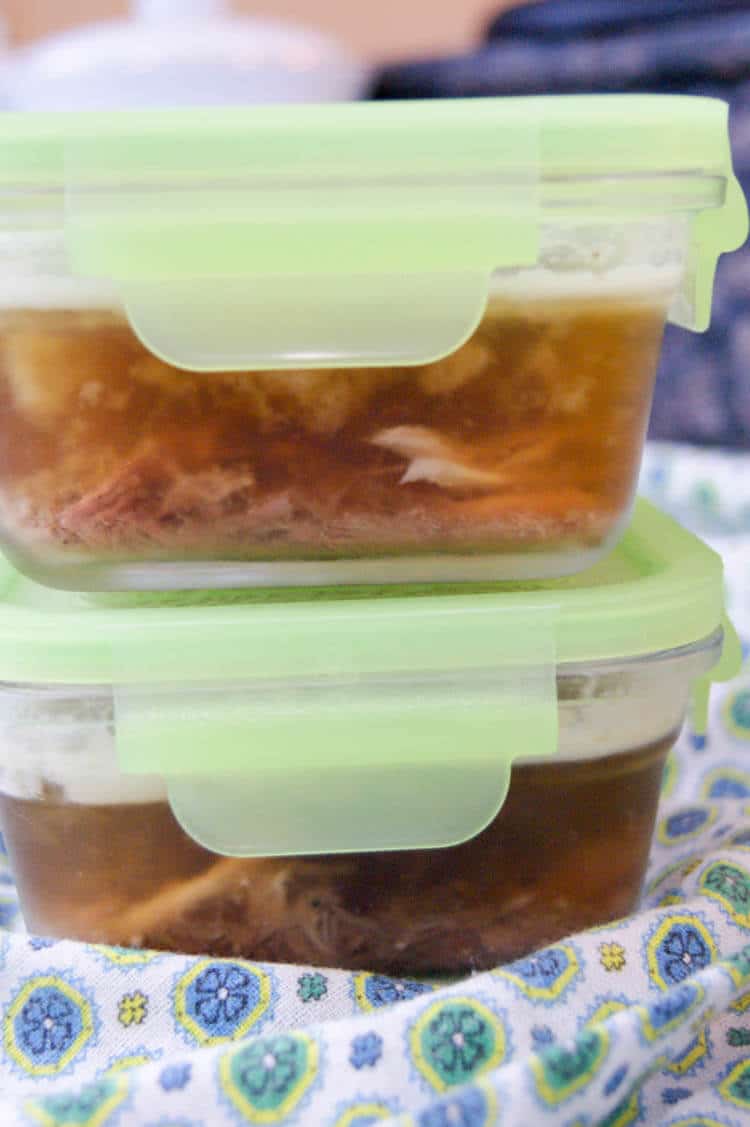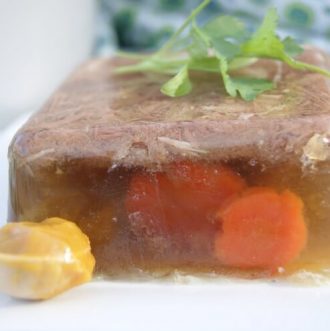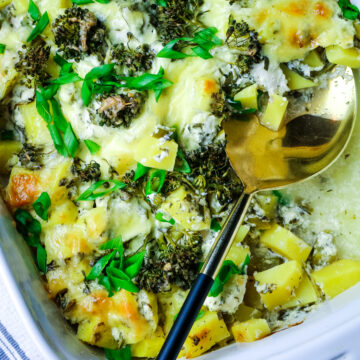Meat jello or Aspic, as it is formally called, is rich in amino acids and nutrients. It's naturally a great source of collagen and helps support bone, teeth and joint health. It's naturally Whole30, Keto, Paleo and GAPS diet compliant.

The History of Jello
Meat jello dates as early as 1375 when the original and detailed Aspic recipe was published in Le Viandier, a collection of the best known recipes of the Middle-Ages.
In 1897, cough syrup manufacturer in LeRoy, New York came up with a concoction for a cough remedy, including laxative and fruit flavoring and we now know that product as Jell-O of course, minus the cough suppressant and laxative, or maybe not. The LeRoy resident, Pearl Wait tried to market his findings but was unsuccessful. (source)
Two years later, he sold his formula to the tune of $450. Today, Jell-O is the largest selling desert and is known worldwide. We don’t consume Jell-O in our house and whether or not you do, that’s your choice (but I highly discourage that you do). What we do eat instead is real and pure gelatin. For instance, this nourishing and delicious aspic.
Note: For jelly-type recipes, we use grass-fed bovine gelatin and collagen products from Perfect Supplements. They carry high-quality collagen products and are leaders in the industry. Click to see what my favorite gelatin products and how you can save on all your purchases.

What is Aspic?
I like to think of Aspic or Meat Jello (Holodets in Russian) as glorified bone broth. And it makes sense as the technique and ingredients used in making bone broth are also similar to aspic. Only with more meat.
In fact, back in the Le Viandier recipe, aspic was used to preserve vegetables, meat and eggs. Of course with the advent of modern-day refrigeration, we don’t need to “preserve” vegetables in meat gelatin.
When making aspic, you want to use the purest ingredients as the slow and long cooking process extracts minerals out of bones and other animal cuts. And by purest ingredients, I mean grass-fed beef or pastured or organic chickens and free from hormones and antibiotics.

Aspic or "Meat Jello" is Supremely Nutritious
The best part about this recipe is its' nutrient content. When you cook bones for an extended period, you are breaking down the collagen, protein found in bone, marrow, cartilage, and tendons and that process produces gelatin.
Gelatin is responsible for aiding protein absorption and soothing the gut lining. That’s why Chicken Noodle Soup is so nourishing for your gut when you are fighting a virus. The collagen/gelatin factor in bone broth or aspic can also make your skin supple and reduce cellulite. Another benefit of bone broth is the healing properties in the form of amino acids that they contain.

There are numerous benefits of bone broth and aspic so it's a given you should have this superfood in your kitchen at all times but I’ll be honest with you, I don’t care for making it.
That’s why I prefer my slow-cooker to do most of the job. This aspic recipe is made out of pork trotters (pig feet) but the meat can be whatever you have on hand. I’ve used leftover turkey from Thanksgiving, or leftover roast chicken meat, or leftover slow-cooked rump roast.
Did you catch the theme? Any leftover meat will work.

How to Make Aspic (Meat Jello) in the Slow Cooker
Toss all ingredients, except the cooked meat into the slow cooker. You can add whatever veggies you typically use when making bone broth. I like celery, onions, carrots (though I add this later) and lots of garlic (with skins).
For spices, I used a combination of bay leaves, peppercorns, rosemary, oregano, basil, and of course my favorite coarse salt, Celtic Salt.

Turn the slow cooker on high and bring to a boiling point. When it reaches a gentle simmer, add carrot and reduce heat to the lowest possible setting and cook for 8 hours (I usually leave this overnight and process it in the morning).
By now, the pork trotters should be falling apart and you should have a very rich, gelatinous bone broth. Divide previously cooked meat of choice in small ramekins or other glassware containers such as pint-size mason jars.

Double strain the broth into a large bowl (I like using this for ease and simplicity) making sure you’re left with very clear, clean golden liquid. If you don’t have a fine-mesh sieve, spread a cheesecloth on a regular sieve to catch all herbs and other debris.
Add fresh minced garlic to the broth and pour into the containers. Add a slice of cooked carrot to each container for garnish and dill or parsley. Discard pork trotters and veggies as you would when making bone broth.
Set aspic in the refrigerator for at least 4 hours. Traditionally, aspic should be served with dijon mustard or horseradish paste.

If you’re going for convenience, small jelly jars or other small containers (with lids) works best. It makes for an easy lunch packing during hectic mornings. If you’re wanting to impress your friends and family, perhaps a bundt pan would look extra fancy.
Printable Recipe

How to Make Aspic (Meat Jello)
Ingredients
- 4 pounds pork trotters about 4-5lbs pig feet
- 2 celery stalks
- 1 large onion
- 1 large carrot
- 10-12 garlic cloves separated
- 2 bay leaves
- 6 tablespoons combined herbs: rosemary, basil, oregano 2 tablespoons each
- 2 tablespoons real salt
- 2 teaspoons whole peppercorns
- 2 cups cooked meat (chicken, beef, turkey, lamb)
- few sprigs of parsley or dill
Instructions
- Toss all ingredients but carrots and cooked meat into a slow cooker.
- Turn the slow cooker on high and bring to a boiling point. When it reaches a gentle simmer, add carrot and reduce heat to the lowest possible setting and cook for 8 hours (I usually leave this overnight and process it in the morning).
- Divide previously cooked meat of choice between small containers.
- Double strain the broth into a large bowl making sure you’re left with very clear, clean golden liquid. Discard pork trotters and veggies as you would when making bone broth (chickens, compost, or trash).
- Add 2 cloves of fresh minced garlic in the broth and pour into the containers.
- Add a slice of cooked carrot to each container for garnish and dill or parsley.
- Set aspic in the refrigerator for at least 4 hours.
- It’s best served with rye bread and Dijon mustard.
Notes
Nutrition
The information shown is an estimate provided for your convenience by an online calculator. It should not be considered as a substitute for a professional nutritionist's advice. See our complete Nutritional Information Disclaimer.
©Prepare and Nourish • Content and photographs are copyright protected. Sharing of this recipe is encouraged and appreciated but please do NOT screenshot or copy/paste complete recipes to websites or social media.
Have you made aspic before? What did you put in it?
If you liked the recipe above, please consider rating the recipe and leaving a comment below. Also, be sure to follow me on Facebook, Instagram, and Pinterest.
>>> Pin This <<<







Chelc | Inside the Fox Den says
How interesting, I've never heard of meat jello before! Thanks for sharing at Merry Monday, hope to see you again next week!
Deborah Davis says
Your photos tutorial is so helpful! I am so delighted that you shared your delicious The When, How and Why of ASPIC with us at the Healthy Happy Green and Natural Party! Thank you so much for sharing your gems and for your support! All the best, Deborah
Anya says
Thank you Deborah.
Emily says
Instructions are very good, but you never say how much water you pit in your slow cooker. I've got to admit I looked up aspic because I saw it on a TV show and it sounded horrible, but I'll try anything once. Save tripe. Not for a million anythings!
Anya says
Hi Emily,
You would fill up to the max line in your slow cooker, generally going for 1:1 ratio of meat/veggies to water. In an average slow cooker you're looking at 3-4 quarts of water. Hope that helps.
Jon says
Whatever is used to parse the recipe and display it in a separate colored box is not processing the anchor tags for the links in the notes section.
Anya says
I see that Jon. Will fix it.
Robyn says
Absolutely terrific!
Anya says
Thank you Robyn.
Rick Morrow says
Go Hungarian and sprinkle it with salt and sweet Hungarian paprika before eating.
Anya says
Great to know, Rick. Thanks for sharing.
Dave T says
This is a nice set of instructions. I went to france about 15 years ago and was served a sliced vegetables in aspic i want to recreate. One small note, is that in addition to the information about cooking, about which you clearly have a lot of information, there is also a lot of pseudoscience/health information. For example, "The collagen/gelatin factor in bone broth or aspic can also make your skin supple and reduce cellulite." I'm not sure if the author just made this up, or found it on some disreputable site, the web is full of misinformation. People should be more careful to write what they know, which you have done carefully for the recipe portion.
Private Person says
I was diagnosed with RA 25 years ago. I have tried everything, but now in my 40s my joints, tendons and nerves really hurt at the end of a day on the farm. ASPIC and any gelatin heavy food reduces the pain and increases my strength and feeling by leaps and bounds. I have started to give my large dogs gelatin and collagen as well, and the one elderly dog we have that has had major joint issues and complaints1 no long whines.
Although this is anecdotal, so is most science (I am a physicist by training), and observation after changing a single variable is the best example of the scientific method. If you or your animals suffer from joint pain, try eating 1-4 tbsp of gelatin/collagen everyday and see for yourself.
Daryl says
Dave there is plenty of information on the benefits of collagen. It's a building block in the human body and studies show collagen production can reduce greatly as we age. The old way of simple making it ourselves instead of paying for a lab to make it.
And knowing the products it's made out of is always a plus.
Sas says
As others have said, there is a lot of good evidence that collagen is beneficial to health in a variety of ways, but in terms of the specific claims you pick up on, there is definitely some scientific evidence supporting them. For improving skin elasticity, hydration & the appearance of wrinkles etc there is a fair amount of evidence, this review summarises some of the research: https://www.ncbi.nlm.nih.gov/pmc/articles/PMC8824545/. And as for cellulite, the evidence is more limited but this paper: https://www.ncbi.nlm.nih.gov/pmc/articles/PMC4685482/ found that collagen supplements improved cellulite.
EPGIRL says
Would you freeze the ramekins or jars of aspic?
Great post, thank you!
Anya says
Hi!! I have not tried freezing aspic but I don't see why it wouldn't work (unless you use lots of uncooked veggies in the aspic). If freezing, use wide-mouth pint jars with an inch of headspace. Let us know how it works out.
tj says
Thanks for the info, I love the jelly around pork pies and sometimes found on pate!
I make up gelatin to freeze to add to soups, stews, curries, etc. but have never used it in a cold dish of my own making, how long do your aspic pots last in the fridge, and do you have any hints on "best practice" regarding the preparation and usage of the meat and veg you use when you say you have used leftovers. I don't store any ready to eat prepared foods (even in the freezer) as I always worry about food poinsoning, so I get anxious about leaving anything in the fridge for more than two days! The effort to produce these lovely looking and tempting jars of goodness is a lot to go to unless they have a longer expected fridge life than a couple of days.
Hope you have dogs to discard your used trotters to, it seems such a waste! I make them into barbeque spare trotters, once the gelatin is strained off, I put my very simple barbeque sauce (marinated ginger, sugar, soy sauce, anise, oil with a little of the gelatin left in the pot) and return the trotters to a hot grill to reheat, turning occasionally, very sticky, very luscious, yum! (I do discard the pigs nails as I just never fancy them though).
Anya says
Our dog enjoys the leftover trotters and veggies. I understand not wanting to store leftovers but this is one of those dishes that with all the effort it takes to make it - you want to make a substantial amount to justify all the work. That's why traditionally, we would always make this when expecting guests with the same appreciation for nourishing food as us. Since it's mainly broth and meat, I can see it would freeze well - just use wide-mouth containers like glass Tupperware and not mason jars. (But truth be told, I've never tried freezing it). Hope that helps, TJ. 🙂
sophia achultz says
Anyone: please share your results if you have frozen Aspic with chicken & veggies. May thanks!
Anya says
I have not tried freezing but if the veggies are cooked, I don't see why it wouldn't work. Let me know how it turns out if you do decide to freeze it.
Lennea says
Question, I want to make pepper jelly for someone who can't eat fruit. Do you think using just the key part of this recipe would work for a base to add the misc peppers, vinegar and sugar to?
Anya says
Hi Lennea,
I truly don't know. I've never made pepper jelly before so I wouldn't know how to incorporate the two recipes. Perhaps using a regular jelly recipe would be better?
Marion Emanatian says
As a small child my Canadian grandparents made a dish I can't spell or pronounce, but it was made with pigs feet and it was served in a pretty bowl with hard boiled egg slices and it had meat in it and it was spread on bread. I think this is it! What do you think?
Anya says
What you are describing sounds a lot like Aspic, Marion! Although it's not typically spread on bread since the texture would make it impossible to do so.
Richard raucina says
Nice but don't toss the pigs feet [just the bones] chop up the meat and skin and add to your aspic. That is the very best part!
Vincent Ree says
After putting in then taking out of the refrigerator, don't you have to remove the top layer of congealed fat?
For instance, I will often make a roast chicken holding off on onions or garlic (*).
Instead of making gravy, I will collect the drippings (*), put them in a container, and put in the fridge. Then, the next morning, I remove the congealed fat layer at the top from the gelatinous mixture below which I would assume is a simple aspic.
(*) I usually make this for my dogs even though I love it too. So, because dogs have a very strong sense of smell, I can safely water this down a bit. The aspic may not be as firm, but the point isn't to serve aspic; it is to take spoonfuls and add to the dog food to give flavor and nutrition. Since any vegetable in the allium plant family (which includes any form of onion, shallot, leek, chives, garlic) is poisonous to dogs, I avoid using them.
Anya says
Hi Vincent,
That is a personal preference. You may scrape it off but it doesn't bother me -- there usually isn't too much fat when I make aspic and I typically invert it onto a plate so the fat is on the bottom. Hope that helps.
Zdenka says
I love this dish! In my culture (slovak) we serve it with freshly chopped onions and vinegar on top. Eat with bread.